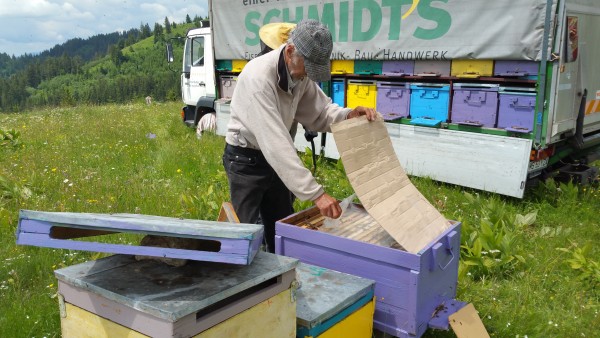My business trips regularly take me to Eastern Europe, where I have met beekeepers and their working methods time and again in recent years, which have both surprised and inspired me.
In Romania we met a migratory beekeeper in the Carpathian Mountains, who works in spring and summer on the lush green and flowering meadows of the Carpathians and spends autumn and winter in the warmer south of Romania. He himself was already a pensioner and spends his retirement together with his wife in their caravan in summer and in their own house in winter. That his Carpatica bees are more resilient than my gentle Buckfast, I experienced very impressively (see photo).
In Ukraine beekeeping has a centuries-old tradition and beekeepers have joined together in local and national associations. The country's economic backwardness favours beekeeping in that large areas have not yet been affected by industrial agriculture and have been able to preserve a high diversity of plants and intact natural systems that provide the bee with abundant and varied food.
In the north I could observe beekeepers, who traditionally prepare stem pieces and hang them in other trees in the forest, where the "dark bee" (Apis mellifera mellifera) then naturally settles. In the endless woods near the jumps of Pripyat, bears also try their luck again and again to get their hands on the sweet gold, and the log hives hang accordingly high - up to 12 metres high, where the beekeeper only needs a rope and a board to sit on. At this dizzying height, he then works on the colonies virtually unsecured.
In the west of the Ukraine they are busy breeding the Carpathian bee (Apis mellifera carpatica). It is particularly resistant to the harsh winters in the mountains, does not swarm as strongly and can therefore achieve a higher honey yield. Another positive characteristic is a comparatively high resistance to varroasis, which is a major concern for beekeepers in Western Europe.
I was particularly interested in the rich knowledge of Ukrainians about bee products for human health. There are countless products made from honey, pollen, bee bread, propolis, royal jelly and bee venom, which are used as medicine or prophylactic products. The most impressive was the beehive where patients breathe in the healthy air of the hive and use the warmth and buzzing of the bees for relaxation. I cannot yet tell my wife about it, but I am already thinking about the best place to build and operate such a hive in the Gutland...
The easiest way to a stable health is of course to take a regular teaspoonful of honey. Just 60-120 g per day is enough to rid the body of all inflammation. But you don't have to go to Eastern Europe for this, you can also get the honey here, in our shop.





